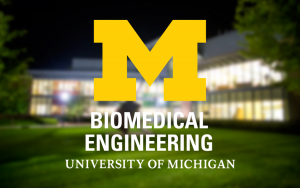Presented By: Biomedical Engineering
PhD Defense: David Martel
Role of the Cochlear Nucleus Circuitry in Tinnitus and Hyperacusis

NOTICE: This event will be held via Zoom. The link will be provided below.
Zoom: https://umich.zoom.us/j/2019377962
Tinnitus is the disorder of phantom sound perception, while hyperacusis is abnormally increased loudness growth. Tinnitus and hyperacusis are both associated with hearing loss, but hearing loss does not always occur with either condition, implicating central neural activity as the basis for each disorder. Furthermore, while tinnitus and hyperacusis can co-occur, either can occur exclusively, suggesting that separate pathological neural processes underlie each disorder.
Mounting evidence suggests that pathological neural activity in the cochlear nucleus, the first central nucleus in the auditory pathway, underpins hyperacusis and tinnitus. The cochlear nucleus is comprised of a ventral and dorsal subdivision, which have separate principle output neurons with distinct targets. Previous studies have shown that dorsal cochlear nucleus fusiform cells show tinnitus-related increases in spontaneous firing with minimal alterations to sound-evoked responses. In contrast, sound-evoked activity in ventral cochlear nucleus bushy cells is enhanced following noise-overexposure, putatively underlying hyperacusis. While the fusiform-cell contribution to tinnitus has been well characterized with behavioral and electrophysiological studies, the bushy-cell contribution to tinnitus or hyperacusis has been understudied.
This dissertation examines how pathological neural activity in cochlear nucleus circuitry relates to tinnitus and hyperacusis in the following three chapters.
In the first chapter, I characterize the development of a high-throughput tinnitus behavioral model, which combines and optimizes existing paradigms. With this model, I show that animals administered salicylate, a drug that reliably induces tinnitus at high doses in both humans and animals, show behavioral evidence of tinnitus in two separate behavioral tests. Moreover, in these same animals, I show that dorsal-cochlear-nucleus fusiform cells exhibit frequency-specific increases in spontaneous firing activity, consistent with noise-induced tinnitus in animals.
In the second chapter, I show that following noise-overexposure, ventral-cochlear-nucleus bushy cells demonstrate hyperacusis-like neural firing patterns, but not tinnitus-specific increases in spontaneous activity. I contrast the bushy-cell neural activity with established fusiform-cell neural signatures of tinnitus, to highlight the bushy-cell, but not fusiform-cell contribution to hyperacusis. These analyses suggest that tinnitus and hyperacusis likely arise from distinct neural substrates.
In the third chapter, I use computational modelling of the auditory periphery and bushy-cell circuitry to examine potential mechanisms that underlie hyperacusis-like neural firing patterns demonstrated in the second chapter. I then relate enhanced bushy-cell firing patterns to alterations in the auditory brainstem response, a sound-evoked electrical potential generated primarily by bushy cells. Findings in this chapter suggest that there are multiple hyperacusis subtypes, arising from separate mechanisms, which could be diagnosed through fine-tuned alterations to the auditory brainstem response.
Chair: Dr. Susan Shore
Zoom: https://umich.zoom.us/j/2019377962
Tinnitus is the disorder of phantom sound perception, while hyperacusis is abnormally increased loudness growth. Tinnitus and hyperacusis are both associated with hearing loss, but hearing loss does not always occur with either condition, implicating central neural activity as the basis for each disorder. Furthermore, while tinnitus and hyperacusis can co-occur, either can occur exclusively, suggesting that separate pathological neural processes underlie each disorder.
Mounting evidence suggests that pathological neural activity in the cochlear nucleus, the first central nucleus in the auditory pathway, underpins hyperacusis and tinnitus. The cochlear nucleus is comprised of a ventral and dorsal subdivision, which have separate principle output neurons with distinct targets. Previous studies have shown that dorsal cochlear nucleus fusiform cells show tinnitus-related increases in spontaneous firing with minimal alterations to sound-evoked responses. In contrast, sound-evoked activity in ventral cochlear nucleus bushy cells is enhanced following noise-overexposure, putatively underlying hyperacusis. While the fusiform-cell contribution to tinnitus has been well characterized with behavioral and electrophysiological studies, the bushy-cell contribution to tinnitus or hyperacusis has been understudied.
This dissertation examines how pathological neural activity in cochlear nucleus circuitry relates to tinnitus and hyperacusis in the following three chapters.
In the first chapter, I characterize the development of a high-throughput tinnitus behavioral model, which combines and optimizes existing paradigms. With this model, I show that animals administered salicylate, a drug that reliably induces tinnitus at high doses in both humans and animals, show behavioral evidence of tinnitus in two separate behavioral tests. Moreover, in these same animals, I show that dorsal-cochlear-nucleus fusiform cells exhibit frequency-specific increases in spontaneous firing activity, consistent with noise-induced tinnitus in animals.
In the second chapter, I show that following noise-overexposure, ventral-cochlear-nucleus bushy cells demonstrate hyperacusis-like neural firing patterns, but not tinnitus-specific increases in spontaneous activity. I contrast the bushy-cell neural activity with established fusiform-cell neural signatures of tinnitus, to highlight the bushy-cell, but not fusiform-cell contribution to hyperacusis. These analyses suggest that tinnitus and hyperacusis likely arise from distinct neural substrates.
In the third chapter, I use computational modelling of the auditory periphery and bushy-cell circuitry to examine potential mechanisms that underlie hyperacusis-like neural firing patterns demonstrated in the second chapter. I then relate enhanced bushy-cell firing patterns to alterations in the auditory brainstem response, a sound-evoked electrical potential generated primarily by bushy cells. Findings in this chapter suggest that there are multiple hyperacusis subtypes, arising from separate mechanisms, which could be diagnosed through fine-tuned alterations to the auditory brainstem response.
Chair: Dr. Susan Shore